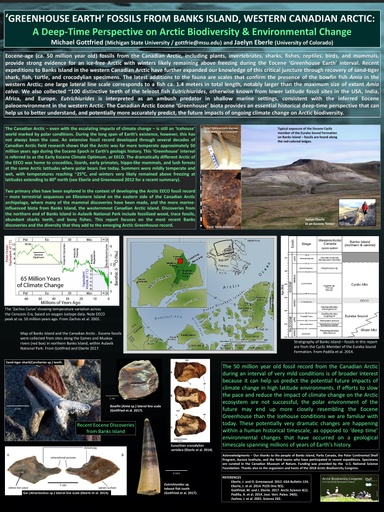pdf ‘Greenhouse Earth’ fossils from Banks Island, western Canadian Arctic: a deep-time perspective on Arctic biodiversity and environmental change Popular
2144 downloads

Michael Gottfried
Michigan State University
Eberle, Jaelyn, University of Colorado, Boulder, Colorado, USA.
 Eocene-age (ca. 50 million years old) fossils from the Canadian Arctic, including plants, invertebrates, sharks, fishes, reptiles, birds, and mammals, provide strong evidence for an ice-free Arctic with winters likely remaining above freezing during the Eocene ‘Greenhouse Earth’ interval. Recent expeditions to Banks Island in the western Canadian Arctic have further expanded our knowledge of this critical juncture through recovery of sand-tiger shark, fish, turtle, and crocodilian specimens. The latest additions to the fauna are scales that confirm the presence of the bowfin Amia in the western Arctic; one large lateral line scale corresponds to a fish ca. 1.4 meters in total length, notably larger than the maximum size of extant Amia calva. We also collected ~100 distinctive teeth of the teleost fish Eutrichiurides, otherwise known from lower latitude fossil sites in the USA, India, Africa, and Europe. Eutrichiurides is interpreted as an ambush predator in shallow marine settings, consistent with the inferred Eocene paleoenvironment in the western Arctic. The Canadian Arctic Eocene ‘Greenhouse’ biota as a whole provides an essential historical deep-time perspective that can help us to better understand, and potentially more accurately predict, the future impacts of ongoing climate change on Arctic biodiversity.
Eocene-age (ca. 50 million years old) fossils from the Canadian Arctic, including plants, invertebrates, sharks, fishes, reptiles, birds, and mammals, provide strong evidence for an ice-free Arctic with winters likely remaining above freezing during the Eocene ‘Greenhouse Earth’ interval. Recent expeditions to Banks Island in the western Canadian Arctic have further expanded our knowledge of this critical juncture through recovery of sand-tiger shark, fish, turtle, and crocodilian specimens. The latest additions to the fauna are scales that confirm the presence of the bowfin Amia in the western Arctic; one large lateral line scale corresponds to a fish ca. 1.4 meters in total length, notably larger than the maximum size of extant Amia calva. We also collected ~100 distinctive teeth of the teleost fish Eutrichiurides, otherwise known from lower latitude fossil sites in the USA, India, Africa, and Europe. Eutrichiurides is interpreted as an ambush predator in shallow marine settings, consistent with the inferred Eocene paleoenvironment in the western Arctic. The Canadian Arctic Eocene ‘Greenhouse’ biota as a whole provides an essential historical deep-time perspective that can help us to better understand, and potentially more accurately predict, the future impacts of ongoing climate change on Arctic biodiversity.

